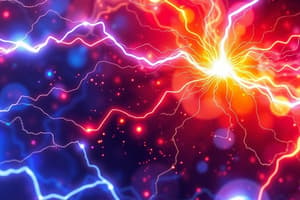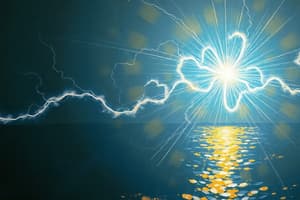Podcast
Questions and Answers
What does Kirchhoff's current law state regarding currents at a junction?
What does Kirchhoff's current law state regarding currents at a junction?
- Currents at a junction are independent of each other.
- The total current entering equals the total current leaving the junction. (correct)
- The total current entering is always greater than the total current leaving.
- The total current at a junction is twice the current entering.
Which formula correctly relates electric power to current and voltage?
Which formula correctly relates electric power to current and voltage?
- P = IV (correct)
- P = V/R
- P = VI^2
- P = I/R
What is the primary role of electromotive force (EMF) in a circuit?
What is the primary role of electromotive force (EMF) in a circuit?
- It provides the voltage necessary to drive currents. (correct)
- It acts as a force that moves charges.
- It measures the resistance of the circuit.
- It converts electrical energy into mechanical energy.
How can you calculate the electrical energy consumed by a component?
How can you calculate the electrical energy consumed by a component?
Which statement about Kirchhoff's voltage law is correct?
Which statement about Kirchhoff's voltage law is correct?
What is the unit of electric current?
What is the unit of electric current?
Which equation represents Ohm's Law?
Which equation represents Ohm's Law?
What happens to the resistance of a conductor if its length is doubled, assuming the cross-sectional area and material remain the same?
What happens to the resistance of a conductor if its length is doubled, assuming the cross-sectional area and material remain the same?
What is the effect of temperature on the resistance of most conductors?
What is the effect of temperature on the resistance of most conductors?
How is the total resistance in a series circuit calculated?
How is the total resistance in a series circuit calculated?
In a parallel circuit, what remains constant across all components?
In a parallel circuit, what remains constant across all components?
Which factor does NOT affect the resistance of a conductor?
Which factor does NOT affect the resistance of a conductor?
What is the mathematical relationship between resistance, resistivity, length, and cross-sectional area?
What is the mathematical relationship between resistance, resistivity, length, and cross-sectional area?
Flashcards
Kirchhoff's Current Law (KCL)
Kirchhoff's Current Law (KCL)
The total current flowing into a junction (or node) is equal to the total current flowing out of the junction.
Kirchhoff's Voltage Law (KVL)
Kirchhoff's Voltage Law (KVL)
The sum of the voltages around any closed loop in a circuit is zero.
Electric Power
Electric Power
The rate at which electrical energy is converted to another form of energy (e.g., heat, light, mechanical work)
Electromotive Force (EMF)
Electromotive Force (EMF)
Signup and view all the flashcards
Electrical Energy
Electrical Energy
Signup and view all the flashcards
Electric Current
Electric Current
Signup and view all the flashcards
Direction of Conventional Current
Direction of Conventional Current
Signup and view all the flashcards
Potential Difference (Voltage)
Potential Difference (Voltage)
Signup and view all the flashcards
Resistance
Resistance
Signup and view all the flashcards
Resistivity (ρ)
Resistivity (ρ)
Signup and view all the flashcards
Series Circuit
Series Circuit
Signup and view all the flashcards
Parallel Circuit
Parallel Circuit
Signup and view all the flashcards
Ohm's Law
Ohm's Law
Signup and view all the flashcards
Study Notes
Electric Current
- Electric current is the rate of flow of electric charge.
- Measured in amperes (A), where 1 A = 1 coulomb per second (C/s).
- Conventional current flows in the direction of positive charge flow.
- Opposite to the direction of electron flow (electrons are negatively charged).
- Produced by a potential difference (voltage) across a conductor.
- Greater potential difference results in greater current, assuming constant resistance.
Ohm's Law
- Current through a conductor is directly proportional to the voltage across it.
- Mathematically expressed as: V = IR (Voltage = Current × Resistance)
- Resistance opposes the flow of electric current.
- Measured in ohms (Ω).
Resistance and Resistivity
- Resistance is a material property opposing current flow.
- Depends on material, length, and cross-sectional area.
- Resistivity (ρ) measures resistance of a unit length with unit cross-sectional area.
- A measure of how hard it is for charge carriers to flow.
- Related to resistance, length (L), and cross-sectional area (A) by: R = ρL/A
Factors Affecting Resistance
- Material: Different materials have varying resistivities, influencing resistance.
- Length: Longer conductors have higher resistance.
- Cross-sectional area: Wider conductors (larger area) have lower resistance.
- Temperature: Temperature affects resistivity, primarily increasing resistance in conductors.
Series Circuits
- Components connected end-to-end in a single path.
- Current is the same through all components.
- Total resistance is the sum of individual resistances: Rtotal = R1 + R2 + ...
- Total voltage is the sum of voltages across each component.
Parallel Circuits
- Components connected across the same two points.
- Voltage is the same across each component.
- Reciprocal of total resistance is the sum of reciprocals of individual resistances: 1/Rtotal = 1/R1 + 1/R2 + ...
- Total current is the sum of the currents through each branch.
Electric Power
- Rate at which electrical energy is converted to another form.
- Measured in watts (W).
- Power (P) relationship with voltage (V) and current (I): P = IV = I2R = V2/R.
Kirchhoff's Laws
- Kirchhoff's Current Law (KCL): Total current entering a junction equals total current leaving.
- Kirchhoff's Voltage Law (KVL): Sum of voltages around any closed loop in a circuit is zero.
Electromotive Force (EMF)
- Energy supplied by a source (battery, generator) per unit charge.
- Not a force but a potential difference established by the source.
- Often referred to as voltage.
Electrical Energy
- Calculated as E = P × t, where E is energy, P is power, and t is time
Studying That Suits You
Use AI to generate personalized quizzes and flashcards to suit your learning preferences.
Description
Test your knowledge of electric current, Ohm's Law, and resistance with this quiz. Explore the relationships between voltage, current, and resistance, and understand the fundamentals of electrical engineering concepts. Perfect for students studying physics or related subjects.




